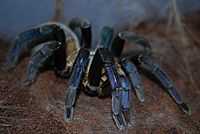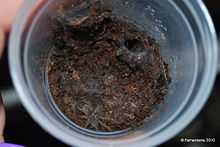Cobalt blue tarantula
| Cobalt Blue Tarantula | |
|---|---|
 | |
| Scientific classification | |
| Kingdom: | Animalia |
| Phylum: | Arthropoda |
| Class: | Arachnida |
| Order: | Araneae |
| Family: | Theraphosidae |
| Subfamily: | Ornithoctoninae |
| Genus: | Haplopelma |
| Species: | H. lividum |
| Binomial name | |
| Haplopelma lividum Smith, 1996 | |
The cobalt blue tarantula (Haplopelma lividum) is a tarantula species that is native to Myanmar and Thailand.
Description

The cobalt blue tarantula is a medium size tarantula with a leg span of approximately 13 cm (5"). The cobalt blue tarantula is noted for its iridescent blue legs and light gray prosoma and opisthosoma, the latter of which may contain darker gray chevrons.[1] Males and females look the same until the ultimate (final) molt of the males. At this point the male will exhibit sexual dimorphism in the form of a light tan or bronze coloration and legginess. Additionally males will gain embolus on the pedipalps and tibial apophysis (mating hooks). The female will eventually become larger than the male and live years longer than the male.[2] The cobalt blue tarantula is a fossorial species and spends nearly all of its time in deep burrows of its own construction.
Habitat
The cobalt blue tarantula inhabits the tropical rain forests of southeast Asia.[3] Here they construct deep burrows, and generally only leave them to find food.
Pets

The cobalt blue tarantula is a mainstay in the pet trade, despite being a fast and defensive tarantula with potent venom.[4] Typically they are kept in a deep tank with 25 to 30 cm (10-12 inches) of substrate such as peat moss or coco-husk that is kept humid.[5]
Notes
- ↑ Photos of Haplopelma lividum
- ↑ http://www.everything-cobalt-blue.com/cobalt-blue-tarantula.htm
- ↑
- Smith, A. M. (1996). "A new species of Haplopelma (Araneae: Theraphosidae), with notes on two close relatives". Mygalomorph 1: 21–32.
- ↑ Tarantulas Bite: Two Case Reports of Finger Bite from Haplopelma lividum. TAKAOKA MAKOTO The Japanese journal of toxicology. vol: 14 issue: 3 page: 247-250 year: 2001
- ↑ Schultz, Stanley A. The Tarantula Keeper's Guide: Comprehensive Information on Care, Housing, and Feeding. Barrons, 2009. ISBN 0764138855
External links
| Wikimedia Commons has media related to Haplopelma lividum. |
- Cobalt Blue Tarantula Care Guide
- Haplopelma lividum at care-sheet.com (WikiPets)